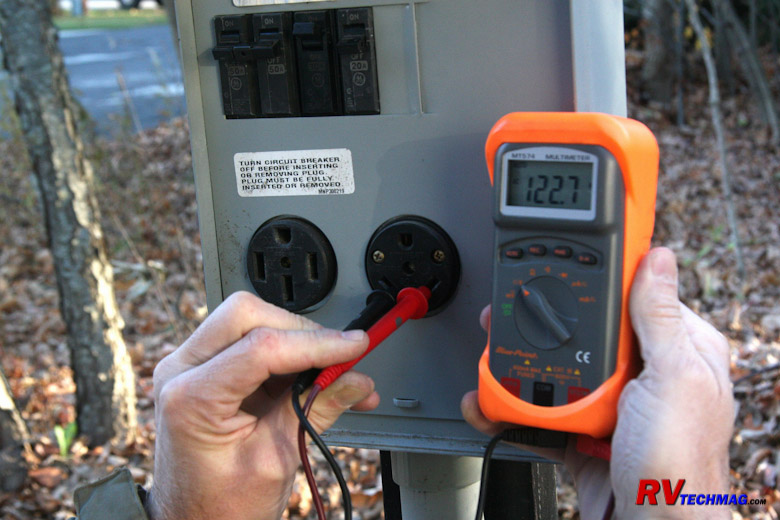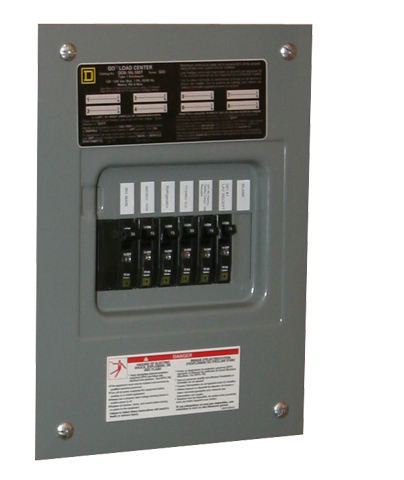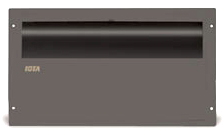|
RV Electrical Tutorial

Chapter 6 - Breaker Panels
Breaker panels serve two functions. They provide a central distribution center for all of the various circuits
to tie into the incoming power supply and they also provide overload protection to prevent fires from any short circuits. Fuses
are pretty much a thing of the past on high voltage circuits in RVs so resetable circuit breakers are provided in their place.
Breaker panels, also called power distribution centers, are mounted in an accessible location inside the RV so that the circuit
breakers can be reset as needed. They are also used to kill a given circuit so that circuit can be safely worked upon without
endangering the operator.

Typical Circuit Breaker Panel
Circuit breaker panels are going to vary quite a bit from one brand to the next as well as between a 30 amp and
a 50 amp service. A 30 amp service will be single pole 120 volts so it will have 3 wires feeding it - a black hot wire, a white
neutral wire, and a green or bare copper ground wire. Because it's a single pole service all of the breakers will be fed by the
same common hot wire. A 50 amp service will be different because it's a two pole split phase service with two hot wires. In this
case the black wire will be referred to as L1 while the second hot phase will be a red wire and referred to as L2. In this instance
the breaker panel will have two main lug inputs and a divided buss that sends L1 to half of the breakers while sending L2 to the
other half. In either situation there will be a main breaker that controls power to the entire distribution panel. It will either
be a single pole 30 amp breaker or a two pole 50 amp breaker, depending upon which service your motorhome is equipped with.
In addition to the main breaker there will be a number of output breakers - one for each circuit in the coach. Any
given circuit may contain multiple outlets but that particular breaker will control every outlet on
its circuit so if a device
that is plugged into an outlet causes the circuit breaker to trip, that entire circuit will be dead. Some of the panels used in
motorhomes are fairly small so that they don't take up too much room, which is somewhat limited in an RV. There may not be enough
available slots for the number of circuits that are needed. Split circuit breakers are commonly used in this application to overcome
that. A split breaker places two half width breakers into one common unit that snaps into a single breaker panel slot. This gives
you the ability to run twice as many circuits as normal circuit breakers. Of course you still need to find enough room inside the
box to stuff all of that wire so that may be the limiting factor.
Sub-Panels:
Normally all of the circuits can be powered from the one breaker panel. Many motorhomes are now coming with more
complex electrical systems and are using inverters to power certain devices. We'll talk more about inverters in a later chapter but
for now let's just say that inverters use battery power to produce 120 volt AC power. Inverters are also fed 120 volt AC power
from the breaker panel. They have an internal transfer switch that passes the shore power through rather than using the batteries
to produce power. It will pass this power through whenever it is available or invert it from the batteries when it is not. This
means that any devices that need to be powered from the inverter need to somehow be connected to
its output. They still require
some sort of overload protection so many of the larger inverters send their output, or the pass through power, to a sub-panel. This
sub-panel will act as a distribution point for all of the circuits that are desired to be run off the inverter. It will have a few
circuit breakers in it to protect these circuits from any overloads. The inverter itself will receive power from either one or two
circuit breakers in the main panel. In this way all of the AC power from the main breaker panel will pass through the inverter and
into the sub-panel, where it can be distributed to the desired circuits. Many of the larger inverters also serve as battery chargers
so whenever shore power or generator power is present it will charge the batteries in addition to operating in the pass through mode.

IOTA IDP-240 Breaker Panel
This requires the installation of a second panel. Adding a sub-panel to an RV does take up valuable space, which isn't
always that easy to do. Some breaker panels, such as the Iota IDP-240B, offer an integral sub-panel. By splitting the buss inside the
panel a portion of that box can be used for sub-panel circuits if the inverter is wired to return power to that portion of the buss bars.
This offers a huge advantage when trying to fit a breaker panel into an RV without tying up valuable space. The Iota is a compact breaker
panel with an attractive cover with smoked glass cover over the breakers. If a breaker trips an LED can be configured to illuminate,
identifying the circuit as tripped without requiring removal of the cover. It can be configured with the split buss design so a separate
inverter fed sub-panel is not necessary.
In the next section we'll talk about batteries and chargers.
Index
|



